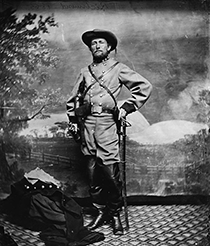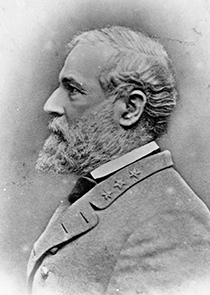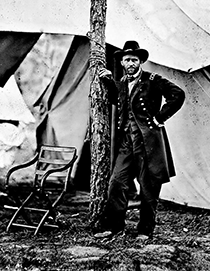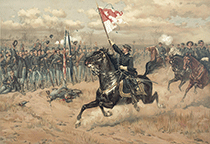Who, What, When, Where, Why: The Facts about Magic in the Mix
Let me be clear: I didn’t write Magic in the Mix in order to teach anyone about the history of the Civil War. I wrote it because I wanted to write a story about Miri and Molly and traveling through time. It’s just a coincidence that if you live in the part of the world that they do (the Shenandoah Valley in Virginia), and you travel through time, you could very well end up in the middle of the Civil War.
It’s totally okay by me if you hate history, but personally, I think the Civil War is fascinating. I love that stuff. I love researching and looking at maps and I love going to battlefields and squinching up my eyes until the Starbucks and the gas stations are blocked out, and I can imagine what it was like in the 1860s.
When I started to write Magic in the Mix, I knew where my girls were located, and I knew that the story would have to be set in the fall, so I got out my Civil War books to see what was going on there in the Shenandoah Valley during the four autumns of the war:
1861, not much.
1862, lots of action, but not in the right place.
1863, not much.
1864, bingo! Phil Sheridan’s Shenandoah Valley Campaign in late summer and fall of 1864! Excellent! Just what I needed!

Colonel John Singleton Mosby
I was already familiar with another guy who was running around the same area during 1864: the elusive John Singleton Mosby, who commanded a battalion of Confederate cavalry (that means soldiers on horses), who called themselves Mosby’s Rangers. A little research on Mosby’s activities during the fall of 1864 led me to the discovery of a weird episode involving prisoners and revenge and hangings that occurred right where Miri and Molly live!
Under the circumstances, how could I resist using the Civil War as the background for my book?
I couldn’t.
However, it’s background. The story itself is not about history, and I hope that people can enjoy the book without knowing anything at all about the Civil War. As I said before, it’s totally okay by me if you hate history. But if you’re interested in history, you might want to know the facts about who did what. And when, and where, and most important of all, why? If so, read on:

General Robert E. Lee
By the fall of 1864, the Civil War had been going on for three and a half years, and the United States—otherwise known as the Union, the Federals, the Northerners, and the Yankees—were, finally, winning. The Confederates—also known as the Rebels, the Southerners, and the Secessionists—had been pushed farther and farther south in the state of Virginia, losing territory that they had once held. By July of 1864, much of northern Virginia was under Union control. But this control was more theoretical than actual, due partly to the activities of Colonel John Singleton Mosby (“the Colonel” of our story). In the middle of 1863, the Commander of the Confederate Army, General Robert E. Lee, had authorized Mosby to operate a cavalry battalion behind Union lines (that means inside the territory the Union had conquered) in northern Virginia in order to “annoy” the Union Army. Mosby was really good at being annoying, and by the autumn of 1864, he and his band of several hundred Rangers had enjoyed a successful and pleasurable fifteen months of sneaking around northern Virginia, West Virginia, and Maryland, shooting up stray Yankee soldiers, robbing trains, and kidnapping Union army officers for the fun of it. Mosby and his rangers were so popular that the local residents in northern Virginia, who were mostly Confederate sympathizers, gladly supported them by hiding them, feeding them, spying for them, and keeping their whereabouts a secret from the Yankee soldiers who were desperate to arrest them. The area of Virginia where Mosby was active is still called Mosby’s Confederacy today.
In addition to being annoyed by Mosby’s Rangers, the Union forces were also harassed on the western and northern edges of Virginia by Confederate troops under the command of General Jubal Early (that’s his real name!), who kept surging northward to fight—and usually win—small battles, once even threatening Washington DC. Early’s scrappy presence presented two problems for the Union army. First, it forced them to keep troops and supplies in the north, when they wanted to concentrate on battles farther south, around Richmond. And second, Early’s troops were protecting the Shenandoah Valley’s rich farmland, which was the main source of food for the Southern forces fighting in Richmond. Between repeated small defeats from the Southern army, Mosby’s Rangers annoying the Yankees and robbing trains in northern Virginia, and the steady stream of supplies moving from the Shenandoah Valley to Richmond, the Union’s leaders were, by summer of 1864, pretty fed up with Virginia in general and the Shenandoah Valley in particular.

General Ulysses S. Grant
In August, 1864, General Ulysses S. Grant, Commander of the US Army, decided he would solve the problem of the Valley once and for all. He assigned Major General Philip Sheridan to lead his 31,000-man Army of the Shenandoah south out of Harpers Ferry, pushing the Confederate troops down out of the Valley. But Sheridan’s task was not only military; Grant also ordered him to burn crops and farmland as he went, in order to destroy Richmond’s food source. Sheridan gladly agreed. “The people must be left with nothing,” he wrote, “but their eyes to weep with . . . ” The fighting began on August 16 at the Battle of Guard Hill, and continued for two months, concluding at Cedar Creek on October 19.
The Battle of Cedar Creek, gleefully re-enacted by Ray, Robbie, and Ollie the Rot-King in Magic in the Mix, was the final, decisive battle of Sheridan’s Shenandoah Valley Campaign. Crabby Jubal Early was by that time desperate to stop Sheridan’s sweep south. He decided that his best chance for a victory was to stage a surprise attack on Sheridan’s troops at a little spot on the western side of the Valley called Cedar Creek.
Unbeknownst to Early, luck was with him, because on October 16, Sheridan had been called to Washington DC for a strategy meeting. Believing that the problem of the Valley was, essentially, solved, Sheridan set off with a light heart. But in the middle of the night of October 18-19, twenty thousand Confederate troops snuck into position around the sleeping Yankees at Cedar Creek, and, as dawn came, they struck. The Union soldiers, waking from a sound sleep to find themselves under attack, did what most people would do under the circumstances—they ran.

Sheridan at the Battle of Cedar Creek
Around 9 o’clock that morning, Sheridan was enjoying a leisurely ride down the Valley Pike on his way back to rejoin his troops at Cedar Creek when he began to hear the sounds of artillery coming from the south. He decided it was probably one of his generals taking potshots at nearby Confederate troops. But as he continued south, the noise increased, and soon he beheld first a trickle and then a flood of his own soldiers coming toward him in full retreat. At the sight of their commander, these soldiers let out a cheer, and this threw Sheridan into a frenzy. “God damn you, don’t cheer me!” he shouted at them, charging forward toward the battle. “If you love your country, come up to the front! There’s lots of fight in you boys yet, God damn it! Come on back, boys, and give em hell, and we’ll make coffee from Cedar Creek tonight!” Startled, frightened, and inspired, the men followed him, stopping in mid-flight to return to Cedar Creek and fight Early’s troops into the ground. The victory the Union achieved at Cedar Creek that day was due, in large part, to Sheridan’s bravery and leadership.
Colonel Mosby, who was not informed of Early’s plans (Early was jealous of him), did not take part in the Battle of Cedar Creek. But he was well aware of Sheridan’s activities in the Shenandoah Valley. Throughout August, September, and October, as Sheridan fought his way south, Mosby and his Rangers had been taking every opportunity to retaliate. Their attacks on Union trains and soldiers left to defend supposedly conquered territory increased in frequency, violence, and success. To the extreme aggravation of General Grant and the War Department in Washington, Mosby’s Rangers made it nearly impossible move food supplies, wounded men, and troops around northern Virginia, despite Sheridan’s victories. The destruction of the trains was particularly infuriating—no sooner would the US Army engineers get the trains in working order than Mosby and his men would tear them up again, or worse yet, rob the trains (Among his other distinctions, John Mosby was the inventor of the train robbery. Jesse James, who claimed the honor, didn’t rob his first train until 1873.) After several weeks of his Valley Campaign, Sheridan realized that his hard-won victories were being chipped to pieces by Mosby’s Rangers, and he decided to take action. He assigned a unit of riflemen, known as Blazer’s Scouts, to the task of “cleaning out Mosby’s gang.”
There followed a month of raids, gunfights, attacks, and counterattacks. Usually, the Union got the worst of it; Mosby was a brilliant strategist, his men were outstanding fighters, and all of them knew the country far better than their opponents. By the latter half of September, the Union troops assigned to guard trains and maintain order in conquered Virginian territory were so terrified of Mosby’s Rangers that they didn’t dare leave their camps; whenever they did, they were attacked. But it was during one such raid that the Rangers made a fatal error: they shot a Union soldier after he surrendered. Though this might seem like a minor consideration in the middle of the war, when the whole point is to kill the enemy, it was, in fact, a major breach of the rules of combat. A soldier who surrendered was to be made prisoner, not killed.
To Sheridan and his officers, this was outright murder, the act of criminals rather than soldiers, and they were outraged. Their anger was undoubtedly compounded by the month of embarrassing losses they had sustained at the hands of the Rangers; you get the sense, reading their explanations, that they were glad to have an excuse to behave badly, for they immediately proclaimed that they would henceforward treat Mosby’s men not as regular soldiers, but as criminals on the lam. In practical terms, this meant that any Ranger, any suspected Ranger, and any civilian assisting a Ranger would be executed immediately and without investigation. No questions, no trials, and no prisoners.
On September 23rd their new policy into action, taking six captured Rangers out the makeshift jail where they were held and swiftly executing them, four by firing squad and two by hanging. Some of them were offered their freedom in exchange for information about Mosby’s whereabouts; they refused. One of the victims was a seventeen-year-old boy of Front Royal, who was not a member of the Rangers at all.

Colonel Mosby with some of his Rangers
As soon as he received word of this deadly event, Mosby was in his turn outraged and vowed to retaliate. However, at that point he was both wounded and masterminding a major train robbery, which came to be known as “The Greenback Raid” for the astonishing $173,000 in cash netted by the Rangers. With his hands full, Mosby put vengeance on the back burner, though he wrote to General Lee in late October, “It is my purpose to hang an equal number of Custer’s men whenever I capture them.” It was this late-October collection of Union soldiers for Mosby’s revenge that served as the context for Magic in the Mix, but in actual fact, Mosby did not make good his promise of retaliation until November 6, when a unit of Rangers led a group of seven Federal prisoners to their execution.
It was a remarkably half-hearted execution. Four prisoners were condemned to the firing squad, and three were to be hanged, mimicking the deaths of the Rangers killed by Federal troops. The first four were lined up to be shot, but one punched his guard in the face and ran away; two were shot but not killed; and the fourth shot misfired, knocking over the executioner and allowing the prisoner to escape. The three remaining soldiers, who were hung, were the only prisoners who actually died. When the failed executions were reported to Mosby, he was unbothered. “If my motive had been revenge I would have ordered others to be executed in their place & I did not. I was really glad they got away as they carried the story to Sheridan’s army.” His goal “was to prevent the war from degenerating into a massacre . . . It was really an act of mercy.” Though the three murdered Union soldiers would probably have disagreed with this assessment, it was the end of the revenge killings between Mosby’s men and Sheridan’s.
After Cedar Creek, Sheridan had achieved his goals in the Shenandoah Valley, and he and his troops moved east to assist General Grant, who had General Lee and his Army of Northern Virginia pinned down at Petersburg. Most of General Early’s troops also moved east, to reinforce Lee, leaving Early with a reduced force in the Valley. Mosby and his Rangers continued to operate in north-western Virginia until the end of the war—and beyond.
Who Part Two:
Sad to say, the villain of Magic in the Mix, Nick Carter, was an actual person and just as much of a rat as he is in the book. His real name was—ha!—Loughborough Carter, but he was called Nick because of his similarity to Old Nick, that is, the Devil. His own father gave him the nickname. According to John Munson, a Ranger who wrote a memoir of his service entitled Reminiscences of a Mosby Guerilla, Nick Carter and his pal Charley McDonough were “. . . outlaws who accompanied us only by tolerance of the Colonel . . . Colonel Mosby would not permit Charley and Nick to indulge in reprehensible actions when they were with us, but I think he had a sneaking admiration for their bravery, for neither of them knew what fear was . . . Nick Carter belonged to one of the oldest and most aristocratic families in Virginia, but he accumulated such a load of undesirable responsibility and notoriety during the war that he thought it best to leave the country mysteriously at its close.” Carter was well-known throughout the area of Virginia called Mosby’s Confederacy as a murderous, drunken, lying thief; even his loyal relatives, who continued to hide him from the authorities until the end of the war, dreaded to see him coming. Accounts of his activities include swindling a slave; committing a double murder of an ex-slave couple; luring a Union officer out of town by asking for assistance with a horse, and then killing him; and stealing a hundred dollars from his own uncle. Every story about Nick Carter is a violent story: one day he was chatting with a girl he hoped to impress when she began to play with her pet cat. Aggravated that he was getting less attention than the pet, Carter picked up the cat by the scruff of the neck and shot it. That probably got her attention.
At the end of the war, Carter refused to surrender, and he continued to try to kill every Yankee he encountered. Obviously, this led to some problems with the law, and as Robbie notes in Magic in the Mix, Carter disappeared from Virginia in 1865. Though he cannot be definitively traced after that, there were rumors that he led a life of crime in Texas before escaping to Mexico, where he made a living fighting bandits. A letter purporting to be from Carter some years after the war tells of his disappointment in not getting the opportunity to murder a Yankee tourist who happened to be passing through his Mexican village. The documentary evidence, as well as the rumors and myths concerning Nick Carter provide a conclusive portrait of a sociopath who would undoubtedly have spent his life either in prison or an insane asylum but for the accident of war, which made his homicidal impulses temporarily acceptable.
It is impossible not to admire John Singleton Mosby, despite his poor taste in choosing sides during the Civil War. Among the many fine strategists of the Civil War, he was probably the most brilliant and certainly among the most successful. Ingenious, brave, and resourceful, he was everything you could ever wish for in a military leader. Even his enemies thought so; after the war, when Mosby was being pursued as a fugitive criminal, Ulysses Grant himself intervened to extend the standard terms of parole to him. In return, Mosby supported Grant in his bid for the presidency in 1870. This was regarded as high treason by some diehard Confederates, but to my mind, it reveals that Mosby’s adherence to the Confederacy, like Lee’s, was a function of his birthplace and heritage rather than a belief in the righteousness of the Cause. This relieves my conscience about liking him.

General Phil Sheridan
Short, irascible, and vainglorious, Philip Sheridan was not always known for his wisdom, but he could be relied upon for bravery and a good fight. He began his Civil War service as a staff officer, auditing financial records, but soon moved to a more active military role. Once General Grant took over the Union forces, he entrusted Sheridan with leading roles in several campaigns, of which the Shenandoah Valley Campaign of 1864 was the most straightforward success. Sheridan’s behavior at the Battle of Cedar Creek has been called by Civil War historian James McPherson “the most notable example of personal battlefield leadership in the war.” The North, which endured a real lack of heroic triumphs in the war, hailed Sheridan as a hero, and a poem, “Sheridan’s Ride,” immortalized the great victory. Even Rienzi, the horse upon which Sheridan made the notable ride down the Valley Pike, shared in the glory: after death, he was stuffed and remains on display at the National Museum of American History in Washington DC.

